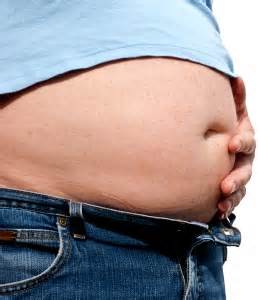How to Burn DANGEROUS Visceral Fat in Stomach Area
All body fat is not equal...you need to know the difference between subcutaneous and visceral fat.
Subcutaneous fat is found just underneath the skin and may cause dimpling and cellulite.
Cellulite causes skin to dimple, pucker up or lump up. There are many factors that determine whether you have cellulite---your genes, gender, skin thickness and amount of body fat all play a part. There are no quick fixes for cellulite.
And, according to the International Journal of Obesity (and many other sources), butt fat is healthier than belly fat. Their research shows that belly fat increases risks of heart attack, stroke, diabetes and premature death.
Women tend to carry too much fat on the butt, hips and thighs while men tend to carry too much belly fat. The research showed that women with more butt fat/thigh fat than belly fat have better blood sugar levels, blood fat control and slower fat turnover (prevents inflammation and promotes metabolic health).
Visceral fat is located in the abdomen and vital organs (such as the liver) and it can be deadly. It can also infiltrate your muscles and heart. Even if you are skinny, you can have visceral fat.
A “skinny fat” person is one who is skinny with high body fat. Studies have shown that frequent yo-yo dieting increases visceral fat. Yo-yo dieters also regain the lost weight (and even more) because yo-yo diets slow down your metabolism.
Work to shrink your waist size. Doing so will reduce your risk of dying from diseases like cancer and heart disease. Researchers from the American Cancer Society warns us about the deadly risks of having too much belly fat.
In the research study led by Eric J. Jacobs, PhD, American Cancer Society strategic director, Pharmacoepidemiology, researchers examined the association between waist circumference and the risk of death among 48,500 men and 56,343 women age 50 and older who had taken part in the Cancer Prevention Study II Nutrition Cohort, a subset of the larger Cancer Prevention Study II (CPS-II).
Participants were tracked for 9 years. “We were interested in looking at waist size because it’s strongly correlated to fat tissue in the abdomen, which is the most dangerous kind of fat issue,” said Jacobs.
Jacobs and his colleagues found that people with very large waists (47 inches or larger in men, 42 inches or larger in women) had approximately twice the risk of death compared to those with the smallest waists (35 inches in men, 30 inches in women) during the study period.
And, this is the interesting part about the study: it didn't matter if the person was normal weight, overweight or obese (according to body mass index).
“We found a pattern showing that expanding waist size was linked to a greater risk of dying regardless of body weight,” said Jacobs. “Similarly, people with the smallest waist sizes had the lowest risk. The take home message here is watch your waist size regardless of your weight.”
So, I say its best to burn both types of fat with regular exercise and healthy, managed nutrition!
Burn total body fat by doing full body strength training. This will help you burn dangerous belly fat. Doing 500 ab crunches a day won't get the job done. If you want to do some extra work on your stubborn body fat areas (in addition to your regular workouts), that okay.
One tactic that will work to help you burn fat is mixing up your cardio workouts. Don't just do running on a treadmill or elliptical machine. You could do a different cardio workout every session to avoid boredom and repetitive stress injuries. Try these cardio workouts to blast fat:
--Bodyweight cardio
--Sprint intervals
--Jump exercise intervals
Mix up your strength workouts between heavy weight sessions (3-5 repetitions per set) and lighter weight circuit training sessions (10-12 repetitions per set).
Subcutaneous fat is found just underneath the skin and may cause dimpling and cellulite.
Cellulite causes skin to dimple, pucker up or lump up. There are many factors that determine whether you have cellulite---your genes, gender, skin thickness and amount of body fat all play a part. There are no quick fixes for cellulite.
And, according to the International Journal of Obesity (and many other sources), butt fat is healthier than belly fat. Their research shows that belly fat increases risks of heart attack, stroke, diabetes and premature death.
Visceral fat is located in the abdomen and vital organs (such as the liver) and it can be deadly. It can also infiltrate your muscles and heart. Even if you are skinny, you can have visceral fat.
A “skinny fat” person is one who is skinny with high body fat. Studies have shown that frequent yo-yo dieting increases visceral fat. Yo-yo dieters also regain the lost weight (and even more) because yo-yo diets slow down your metabolism.
Work to shrink your waist size. Doing so will reduce your risk of dying from diseases like cancer and heart disease. Researchers from the American Cancer Society warns us about the deadly risks of having too much belly fat.
In the research study led by Eric J. Jacobs, PhD, American Cancer Society strategic director, Pharmacoepidemiology, researchers examined the association between waist circumference and the risk of death among 48,500 men and 56,343 women age 50 and older who had taken part in the Cancer Prevention Study II Nutrition Cohort, a subset of the larger Cancer Prevention Study II (CPS-II).
Participants were tracked for 9 years. “We were interested in looking at waist size because it’s strongly correlated to fat tissue in the abdomen, which is the most dangerous kind of fat issue,” said Jacobs.
Jacobs and his colleagues found that people with very large waists (47 inches or larger in men, 42 inches or larger in women) had approximately twice the risk of death compared to those with the smallest waists (35 inches in men, 30 inches in women) during the study period.
And, this is the interesting part about the study: it didn't matter if the person was normal weight, overweight or obese (according to body mass index).
“We found a pattern showing that expanding waist size was linked to a greater risk of dying regardless of body weight,” said Jacobs. “Similarly, people with the smallest waist sizes had the lowest risk. The take home message here is watch your waist size regardless of your weight.”
So, I say its best to burn both types of fat with regular exercise and healthy, managed nutrition!
Burn total body fat by doing full body strength training. This will help you burn dangerous belly fat. Doing 500 ab crunches a day won't get the job done. If you want to do some extra work on your stubborn body fat areas (in addition to your regular workouts), that okay.
One tactic that will work to help you burn fat is mixing up your cardio workouts. Don't just do running on a treadmill or elliptical machine. You could do a different cardio workout every session to avoid boredom and repetitive stress injuries. Try these cardio workouts to blast fat:
--Bodyweight cardio
--Sprint intervals
--Jump exercise intervals
Mix up your strength workouts between heavy weight sessions (3-5 repetitions per set) and lighter weight circuit training sessions (10-12 repetitions per set).
If you want to take your workouts to a higher level and blowtorch body fat, my FREE Bodyweight Metabolic Fat Burner Workouts are what you need. There are 3 levels: Bodyweight 200, 300 and 500. Start at the level you can handle.






